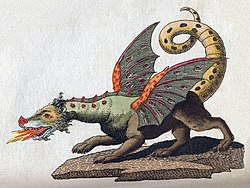Fire breathing dragon

Illustration of a winged dragon by Friedrich Justin Bertuch, 1806.
|
|
| Grouping | Legendary creature |
|---|---|
| Sub grouping | Dragon |
| Similar creatures | Other dragons |
| Mythology | Greek and medieval folklore |
| Region | Europe |
| Habitat | , caves, castles, mountains |
European dragons are legendary creatures in folklore and mythology among the overlapping cultures of Europe.
In the modern period, the European dragon is typically depicted as a large, fire-breathing, scaly, horned, lizard-like creature; the creature also has leathery, bat-like wings, four legs, and a long, muscular prehensile tail. Some depictions show dragons with feathered wings, crests, ear frills, fiery manes, ivory spikes running down its spine, and various exotic decorations. Others have no legs or multiple heads.
In folktales, dragon's blood often contains unique powers, keeping them alive for longer or giving them poisonous or acidic properties. For example, in the opera Siegfried, dragon's blood allows Siegfried to understand the language of the Forest Bird. The typical dragon protects a cavern or castle filled with gold and treasure. An evil dragon is often associated with a great hero who tries to slay it, and a good one is said to give wise advice.
Though a winged creature, the dragon is generally to be found in its underground , a cave that identifies it as an ancient creature of earth. Possibly, the dragons of European and Mid-Eastern mythology stem from misunderstood fossils and exaggerations of species of poisonous lizards and snakes.
English "dragon" derives (via Middle English, Old French, and Latin) from Ancient Greek δράκων drákōn, "serpent, dragon"; the Greek word possibly derives from Indo-European *derk-, "to see", and may originally have meant something like "staring one" (as snakes lack eyelids) or "monster with the evil eye." Notwithstanding their folkloric associations, there is no etymological connection between dragons and the ghoulish figures known as draugar in Old Norse, who haunt rich burial mounds.
Roman dragons evolved from serpentine Greek ones, combined with the dragons of the Near East, in the mix that characterized the hybrid Greek/Eastern Hellenistic culture. From Babylon, the muš-ḫuššu was a classic representation of a Near Eastern dragon. John's Book of Revelation—Greek literature, not Roman—describes Satan as "a great dragon, flaming red, with seven heads and ten horns". Much of John's literary inspiration is late Hebrew and Greek, but John's dragon is more likely to be symbolizing the dragons from the Near East. In the Roman Empire, each military cohort had a particular identifying signum (military standard), after the Parthian and Dacian Wars of Trajan in the east, the Dacian Draco military standard entered the Legion with the Cohors Sarmatarum and Cohors Dacorum (Sarmatian and Dacian cohorts)—a large dragon fixed to the end of a lance, with large, gaping jaws of silver and with the rest of the body formed of colored silk. With the jaws facing into the wind, the silken body inflated and rippled, resembling a windsock.
...
Wikipedia
